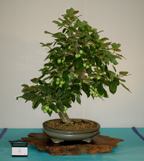
| Articles | Home Page | Images | Order Form | Plant Catalog |
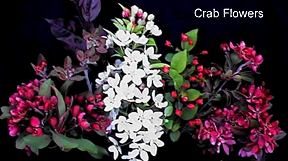 Malus
(Flowering Crabapple) S\M\-30ø\Ls\B Deciduous trees. One of the most
beautiful and useful small ornamental trees. Most trees under 25 feet,
spreading sometimes to 20 feet. Some have pronounced weeping habits. Bare
trees absolutely covered with flowers in spring are a sight to behold. Many
also have showy fruit. Much used for bonsai, the problem has been to get
trees that are not grafted. Almost all of the varieties offered here are
cutting grown to avoid graft unions and will flower in one year. Cuttings
are very vigorous, often growing more quickly than grafts. We have produced
4 inch trunks in 6 years when planted in the ground. Tops June be severely
cut back to produce large trunks with exceptional taper, which is not
feasible with grafts since such pruning stimulates the understock to sucker
heavily.
Malus
(Flowering Crabapple) S\M\-30ø\Ls\B Deciduous trees. One of the most
beautiful and useful small ornamental trees. Most trees under 25 feet,
spreading sometimes to 20 feet. Some have pronounced weeping habits. Bare
trees absolutely covered with flowers in spring are a sight to behold. Many
also have showy fruit. Much used for bonsai, the problem has been to get
trees that are not grafted. Almost all of the varieties offered here are
cutting grown to avoid graft unions and will flower in one year. Cuttings
are very vigorous, often growing more quickly than grafts. We have produced
4 inch trunks in 6 years when planted in the ground. Tops June be severely
cut back to produce large trunks with exceptional taper, which is not
feasible with grafts since such pruning stimulates the understock to sucker
heavily.
Our cuttings are taken from mature flowering wood and are capable of flowering immediately. However, it is my experience that new cuttings June take a year or two to begin flowering under proper conditions. Crabs, like all apples, need a cold dormant period to set flowers and fruit. In general it takes 1000 hours of temperatures below 40F to satisfy this requirement. Smaller trees can even be kept in refrigerators. Most places in the US will have sufficiently cold weather, but I do not recommend crabs for Central and Southern Florida, Southern California, and other areas of the deep south. If in doubt, observe mature crabapples or apples in your community to see if they flower there, or contact your local Agricultural Extension Agent, or a reputable nursery.
Most 2 3/4 inch pots are whips with 1/4 inch caliper or larger and about ten inches tall. Older 2 3/4 inch pots and four inch pot plants have developed branching and 3/8+ inch trunks and many will have set fruit.
| For more information see the article Crabapples for Bonsai........................................................ |  |
| 6100 Malus 'Donald Wyman' 15 feet x
15 feet . Dark green foliage. Profuse white flowers. Small shiny
reddish orange fruits persisting all winter. Cutting grown. ONE GALLON SIZE $55 |
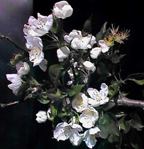 |
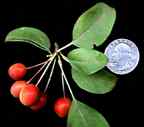 |
6175 Malus 'Madonna' compact upright tree to
18-20 feet x 15 feet. Double white fragrant flowers. Small brownish red
fruits, not showy. Blooms early and long. Cutting grown.
2 3/4 INCH POTS $18
SIX INCH POTS $45
ONE GALLON SIZE $55
| 6195 Malus 'Prairie Fire' Upright
growth to 20 feet. New leaves are purple turning to deep green.
Flower buds are deep red purple. Flowers are single reddish purple
followed by 1/2 inch deep red purple fruits. One of the best
according to Fr. Fiala. Cutting grown. 2 3/4 INCH POTS $18 Sorry, Sold Out SIX INCH POTS Sorry, Sold Out .So...................................................... |
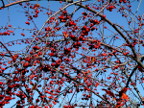 |
| 6220 Malus 'Red Jewel' 15 feet x 15
feet. Dark green leaves. White flowers. Small brilliant red fruit
persisting. Cutting grown. 2 3/4 INCH POTS $18 FOUR INCH POTS $27 SIX INCH POTS $45 ONE GALLON $55 |
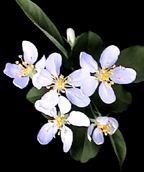 |
| 6263 Malus sargentii 'Tina' This
is a cultivar of sargentii (above) which is a little smaller in
leaf and habit. The flowers are dark pink opening to pure white
creating a spectacular candy cane contrast of pink and white at
the same time. It flowers very well and sets many orange red fruit
. One of the finest cultivars for small bonsai. Due to the slow
growing nature of this tree our one gallon plants are smaller and
shrubbier thanour other Malus cultivars. Cutting grown. 2 3/4 INCH POTS $27 SIX INCH POTS $55 ONE GALLON SIZE $65 |
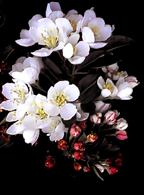 |
6460 Morus bombycis 'Unryu' Contorted
Mulberry. This cultivar can make fantastic larger
bonsai where the size of the 3 to 4 inch leaves won't matter.
The contorted branches also make a good winter silhouette. This
is a female cultivar that will fruit every year even without a
pollinator. The one inch black fruit are showy and edible.
6572 Olea europaea (dwarf
form) (Common Olive)S\D\15ø\Ls\B Similar to the
species above except this form has dwarf dark green leaves and a
much smaller and shrubbier form. Excellent for smaller bonsai;
it forms the same wonderful swollen root crown after many years.
Picea (Spruce) S\M\-50ø\RG\Ls\B Evergreen trees and shrubs. Easy to grow conifers. Many species and varieties including many dwarfs that are invaluable for landscape and rock garden use. We no longer grow any Picea, but we have kept the listings for informational purposes. A word of caution about Yezo spruce and Sachalin spruce: There is a great deal of confusion surrounding the naming of these two species, especially in the use of the common names. Many bonsai artists speak of 'Yezo Spruce' when the plant to which they are referring is actually P. glehnii. We cannot be responsible for how people use common names. We guarantee that our plants are in fact named correctly botanically, so please try to determine which species it is that you would like to order. In general, P. glehnii is the smaller, slower growing species of the two with needle length about 1/2 inch, and dark green. It can be difficult to grow. Most of the time, when people ask for "Ezo Spruce" they really want P. glehnii. Picea jezoensis, also called Ezo Spruce or Edo Spruce or Yeddo Spruce, is slightly larger, faster growing with green needles from about 3/4 to 1 inch long. Picea jezoensis hondoensis, or Hondo Spruce, has slightly bluish green needles of about 1 to 1 1/2 inches long and is the fastest growing of the three, and more widely adaptable. Picea orientalis actually has the shortest needles of the three, and grows strongly and densely despite its diminuative habit. The branchlets are a bit more angular than the others. We are phasing out Picea species, but will leave this discriptive portion for your information. 7065 Picea glehnii (Sachalin
Spruce) S\PS\M\-30ø\LS\B A traditional bonsai plant with very
short bright green needles (about 1/2inch). Very slow growing,
four year old plants June only be 6 inches tall. Exfoliating
chocolate brown bark develops as the tree ages. These plants are
seedlings and are very difficult to find in this country. See
the notes under Picea for more information. 7070 Picea jezoensis hondoensis
(Yezo Spruce, Hondo Spruce) S\PS\M\-50ø\B Long used for bonsai
in Japan, this plant is difficult to find in the US. It has very
short blue green needles and is used for formal upright bonsai
and for group plantings. The foliage is slightly bluer and
larger than the species P. jezoensis. See the
notes under Picea for more information. Seedlings. 7075 Picea orientalis (Oriental
Spruce) S\PS\M\-20ø\Ls\B A very adaptable spruce, surviving
nicely even in very hot climates, some afternoon protection
needed as bonsai. Very dark green foliage is some of the
shortest of any spruce, about 1/4 to 1/2 inch. Grows about three
to six inches a year, eventually reaching over 100 feet. In
youth it is a slow growing fat cone that is very neat and tidy.
|